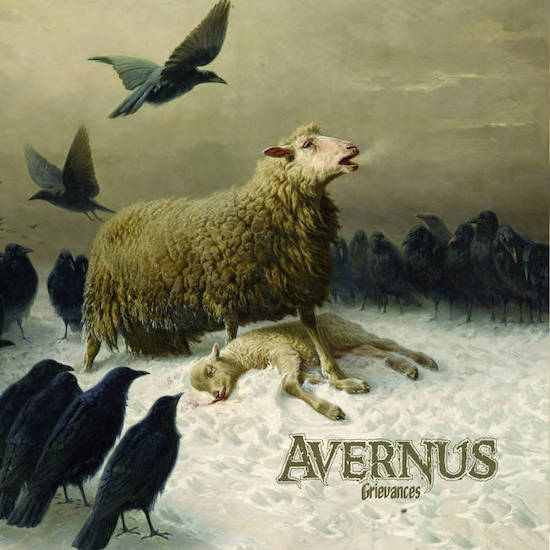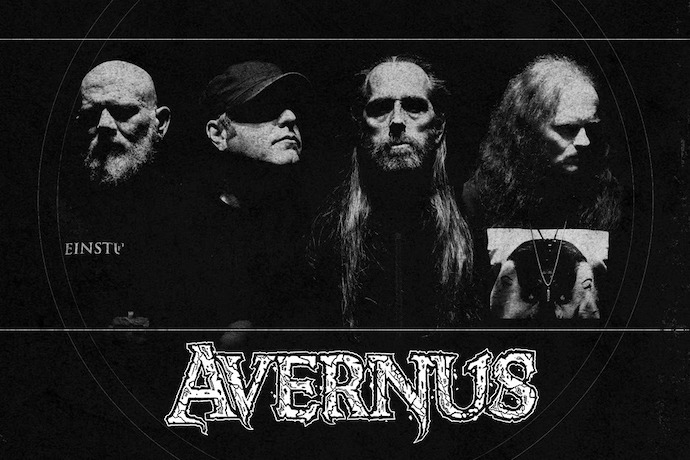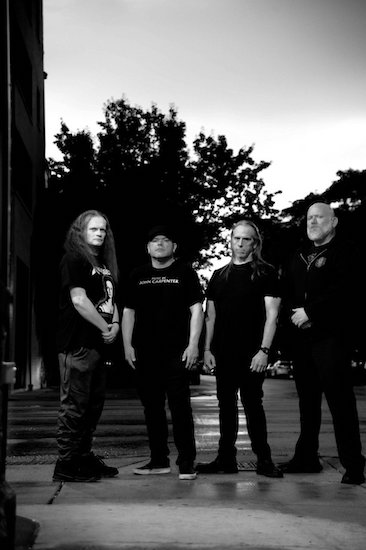
(written by Islander)
The first new album from Chicago’s Avernus in 27 years, which will be released at the end of this week by M-Theory Audio, is something like the closing of a circle (and the opening of other circles). Having been formed in 1992, and with a couple of early demos under their belts, they caught the attention of Marco Barbieri at Metal Blade, who became primarily responsible for including them on that label’s Metal Massacre 12 compilation, and would have signed them to something bigger on Metal Blade if Barbieri had had his way.
Avernus did go on to release their debut album …Of the Fallen on M.I.A. Records in 1997, and they followed that with a few more demos plus an EP, but the band fell away, releasing no new music after 2003… until this year.
Barbieri is now the president of M-Theory Audio, and thus the label’s release of a new Avernus album is a reunion that’s been decades in the making. Avernus has itself experienced a reunion, with a current lineup on the new album that includes three of the band’s original founding members (Rick Yifrach, Erik Kikke, and Rick McCoy), plus James Genenz (also a member of Jungle Rot), who joined the band in 1997.
Reunions of any kind are generally occasions for reminiscing and nostalgia, but this reunion has led to something new, an album of new music made by people who necessarily are very different people than the ones who made …Of the Fallen and all those demos in the ’90s — different because time re-makes everyone, in ways small or large.
What this particular reunion has accomplished, you will discover today, because we’re now premiering a full stream of the new Avernus album. Its name is Grievances. and it is stunning.

Photography by Gene Ambo
“Nemesis” was the first single from the album released earlier this year, timed to coincide with the announcement of the band’s signing with M-Theory and the forthcoming release of the Grievances. In retrospect, it’s understandable why they picked that song to go first, and why they got Alex Zarek to make a video for it. Drummer Rick Yifrach explained what it’s about:
“’Nemesis‘ is a song that reacts to the gross neglect and indifference towards that neglect of Earth. We have polluted to no end, and we continue making a mess of things wherever we are. In the end, the Earth has the last laugh, because she will survive humanity’s ravaging, while we will continue to bury our dead in the very mess we make, the rotten soil.”
At nearly 10 minutes in length, “Nemesis” is a substantial undertaking, a big way of saying “We are back!”
Across those many minutes, “Nemesis” significantly evolves too, moving from sounds that are ethereal and musing, dreamlike and haunting, to sounds that crash and thunder, ringing with the agony of grief. As gravel-toned and well-rounded roars arrive, the music also slugs hard, but misery still trails in its wake, and the song’s moaning and wailing central riff burrows even deeper into the listener’s mood.
The song becomes gentle and haunting again, with synths and guitars casting another sweeping spell. A vibrantly trilling lead guitar and pounding drums lead the music into greater intensity. The drums go off like gunshots, the bass heavily throbs, the guitars rise higher, yearning in their tones, and the band get listeners’ heads moving again too.
“Nemesis” is a thoroughly captivating, and thoroughly heavy and heartbreaking, expression of death/doom, and the video is equally captivating (and sure as hell makes this writer want to see Avernus on stage, and soon.)
Avernus followed “Nemesis” with a second single from the album, “Return to Dust.” Guitarist Erik Kikke explained its subject this way: “’Return To Dust’ reflects on getting older and the inevitability, and acceptance of death. Coming to terms with the end of everything as we know it, and trying to find comfort and solace in that thought.”
Not quite as long as “Nemesis“, but still substantial, “Return To Dust” was also presented with a video. It creates its own heart-aching spell with a beautifully fashioned two-toned harmony, and the vocals are every bit as ravaging as before when they render the despairing and daunting words.
But the drumming in this song also hits hard, booming and cracking as the layered melodies pull the listener down a flowing river of tears. And here too, Avernus use synths, which here mimic orchestral strings, to spirit the mind into the clouds, grey but lined with silver, grief-stricken but gorgeous. The song becomes vast, emotionally fracturing but still a very deep spell.
When you consider these two singles together you realize that Avernus haven’t just “matured” as people, they’ve matured as songwriters and performers too, and the balance of the album only strengthens that conviction.
A central feature of all the songs is how hook-laden they are, which is to say that their grieving melodies dig in and don’t let go. Another is how viscerally powerful the rhythm section are, and yet another is the shattering impact of the cavern-deep and serrated-edge vocals. Avernus also continue to create contrasts between earth-quaking heaviness and borealis-like shining, between bruising earthiness and celestial wonder.

Photography by Gene Ambo
Of course, the overarching mood of the album is dark — you won’t mistake the music for anything other than doom — but Avernus do a very good job giving each song its own personality. Some are more ravaging and angry, others more steeped in longing and loss, others deeply mesmerizing, and still others more geared toward getting heads and bodies moving. Many of them do all these things in the space of a single track.
Avernus also bring in different instrumental accents and tones, some sounding like folk instrumentation — a different kind of earthiness to go along with the spine-shaking and skull-rattling beats and wrenching vocals, and another kind of contrast with the evanescing gothic shimmers and classical orchestration in the upper reaches of the range.
On the other hand, “Utter Euphoria” sounds downright futuristic (a dystopian future, to be sure) and “Abandoned” seems like a journey to a frightening spectral realm. The vocals also vary, with solemn baritone singing briefly taking the stage.
And lest you think that naught but doom reigns across the album, it also climbs towards zeniths of heart-stopping splendor and creates poignant portrayals of wistful introspection. Even within the realm of doom, some songs sound catastrophic, while others sink to their knees in mourning or cry out in anguish.
Moreover, the album is arranged in a way that creates an ebb and flow of moods and intensity, and delivers the biggest surprises and variations in the album’s back half, one more feature that makes it very easy to get pulled into the album and to stay with it until the end, despite its extravagant length.
Well, believe it or not, much more could be said about Grievances, but it’s time to let you form your own impressions. My own is that this is one of the best albums of doom/death metal I’ve come across in a very long time.
AVERNUS:
Rick Yifrach: Drums & Percussion
Erik Kikke: Guitars / Bass Guitar
Rick McCoy: Vocals / Guitar Synthesizer
James Genenz: Guitars / Bass Guitars / Synthesizers / Vocoder
Grievances was produced by Avernus. It was recorded and engineered by Joe Scaletta (Word Of Mouth Recording), with drums recorded at Bricktop Recording. Andy Lagis (Earshot Recording) provided additional recording. The album was mixed and mastered by Charles Macak (Electrowerks Recording).
The distinctive cover art is a painting named “Anguish” (c. 1878) by August Friedrich Schenck.
M-Theory Audio will released Grievances on September 20th, on double-LP vinyl, digipack CD, and digital editions, and they’re all available to order now.
PRE-ORDER:
https://m-theoryaudio.com/store
https://avernus.bandcamp.com/album/grievances
AVERNUS Online:
https://www.facebook.com/avernusdoommetal
https://www.instagram.com/avernusdoom
https://www.avernus.bandcamp.com
